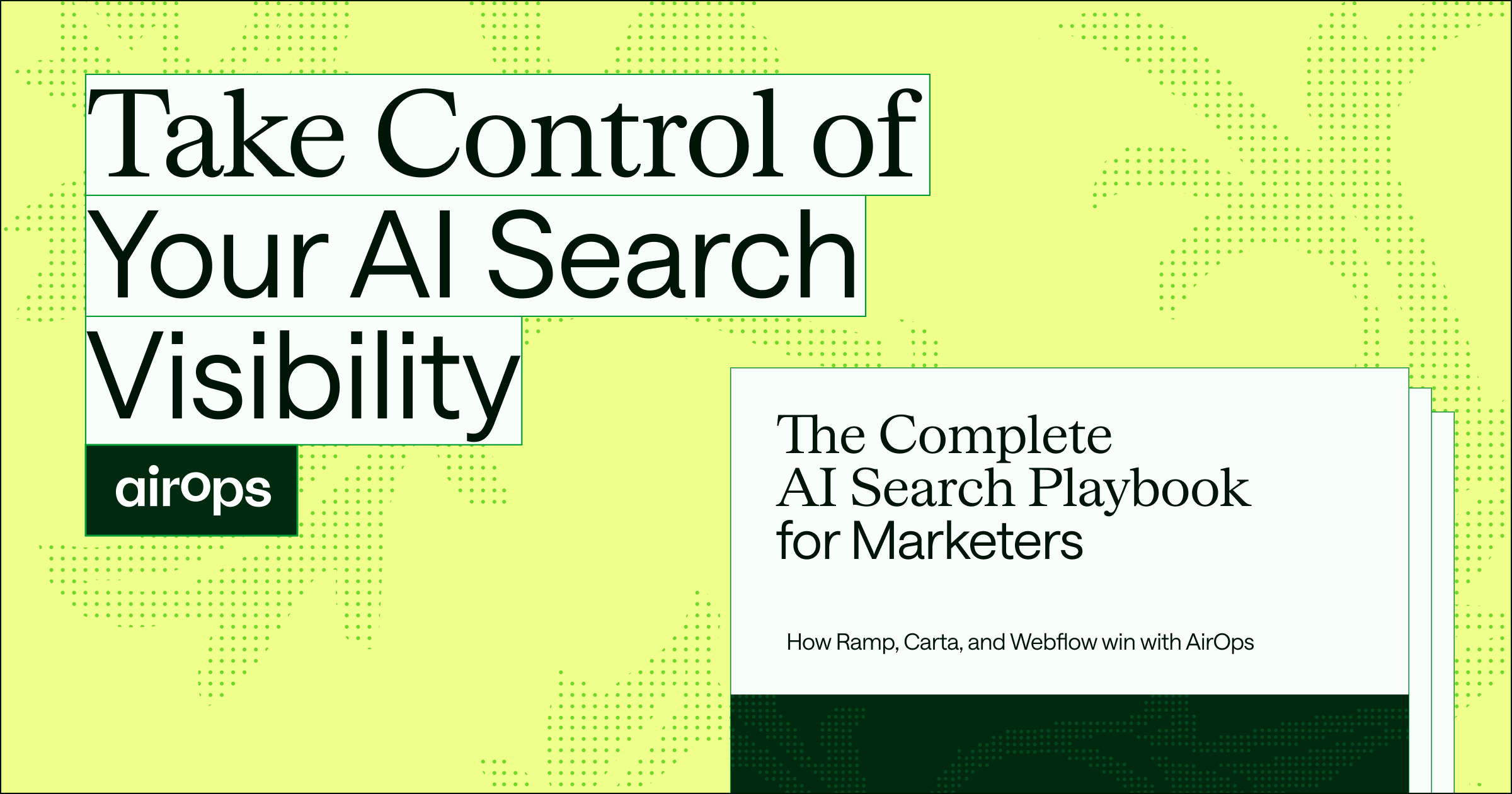The way people get information has changed more in the past year than in the previous twenty.
Search is no longer a list of links. Instead of typing a question into Google and scrolling through ten blue links, billions of people are now getting direct answers from AI assistants like ChatGPT, Claude and Gemini.
That single behavioral change is rewriting how brands are discovered. When your customers stop clicking through, traditional SEO and content strategies stop working. The playbook that defined a generation of growth is collapsing — and with it, the visibility companies have long relied on to reach their audiences.
From learning to decision-making, each answer is powered by content that meets new quality and freshness standards. The brands that show up will win. The ones that don’t will disappear. The best companies are adapting to this reality, not panicking. They’ve built connected systems where visibility, content, and performance feed each other in a continuous loop.
We’ve assembled this guide so you can see exactly what’s working for the leading brands like Carta, Rampa and Webflow across AI search today.
Use this playbook to stay visible, move faster, and turn intelligent systems into lasting growth.
What’s Actually Working Today
The “slop” era is over. High-volume filler stopped working because audiences lost trust and leaders lost patience. Visibility in AI search now depends on credibility that begins on your website, but extends far beyond it.
The rules are still emerging, but that’s the opportunity. With fewer incumbents, the fastest-moving teams are winning by mastering three things: originality, human judgment, and speed.
Based on ~15 million data points across AI answers, queries, citations and brand mentions, a pattern is clear: freshness and speed is the competitive edge. Seventy percent of the pages cited by AI models were updated within the past year, and content less than three months old is three times more likely to be referenced.
Our analysis shows the same pattern across every high-performing team.
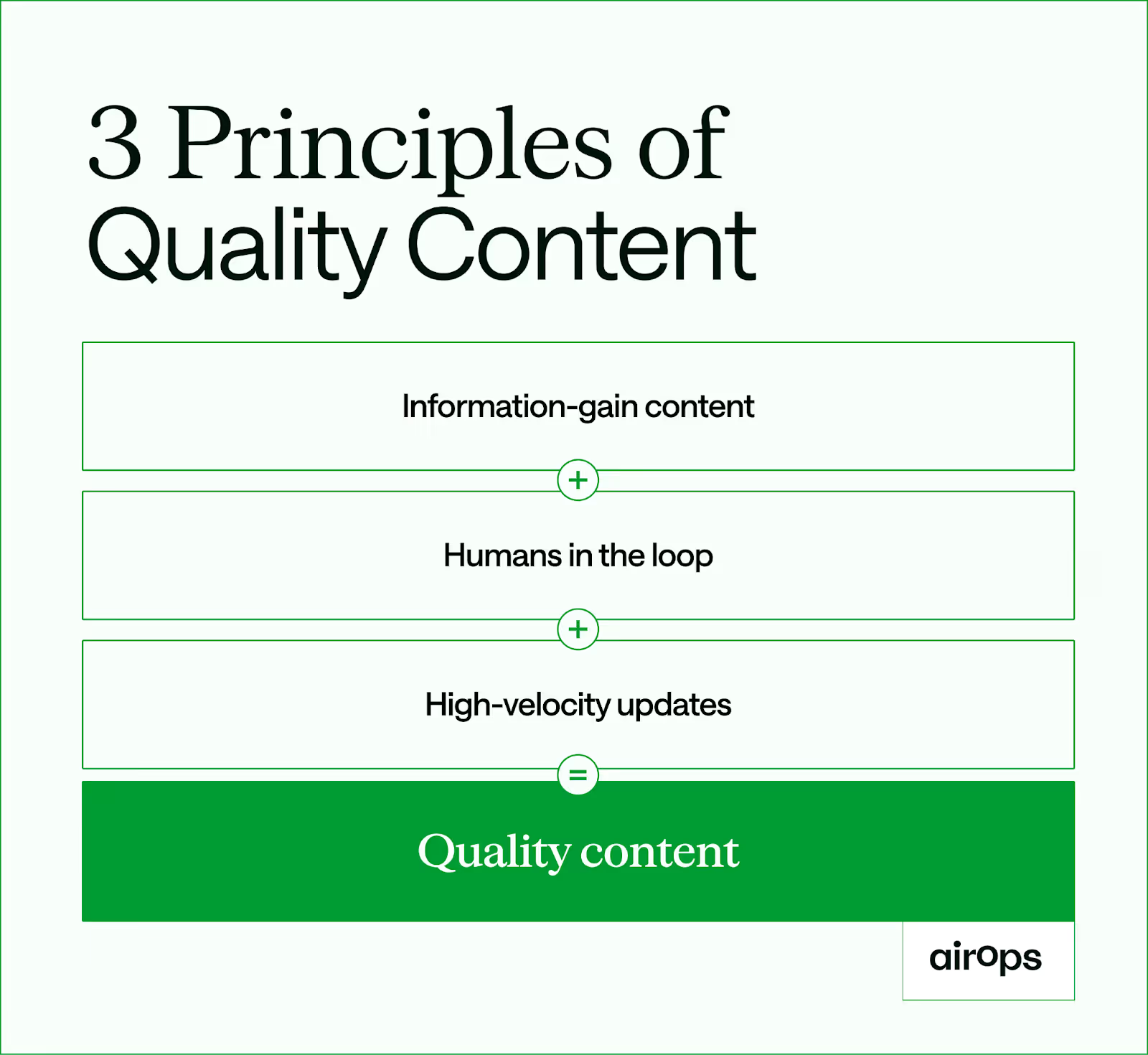
1. Create information-gain content
LLMs reward novelty, not noise. The web is saturated with repetition, and large models filter for sources that add something new. Winning teams compete on information gain. They publish proprietary data, internal insights, and distinct points of view that expands the model’s knowledge, not restate it.
- Carta and Ramp turn internal datasets, customer calls and insights from subject-matter experts into content to generate net-new content that audiences trust and LLMs notice.
- Webflow saw a 6× higher conversion rate from AI-sourced traffic after focusing on original, structured, and authoritative material competitors couldn’t copy.
Takeaway: Authoritative and unique content is now the most defensible moat in AI search.
2. Keep humans in the loop
AI enhances creativity but never replaces it. Top teams use AI to accelerate research and structure while keeping humans in charge of voice, accuracy, and tone. They’ve built workflows where writers, strategists, and systems designers collaborate in real time.
- Teams increasingly invest and upskill around content engineering, a hybrid role that blends editing, systems design, and quality control.
- At Klaviyo, this role orchestrates content systems that merge brand context, data, and human quality together.
Takeaway: Automation works best when it’s guided by judgment. Human oversight is the safeguard that keeps AI-driven content credible.
3. Move at high velocity
Freshness is the new authority signal. AI models overwhelmingly cite content that’s recent and actively maintained. Pages updated within three months are three times more likely to be cited, and >60% of commercial pages cited by ChatGPT were updated in the past six months.
Given the increased requirements in refresh frequency, teams are building systems to not only keep up, but make this their advantage.
- Chime used AI-assisted refreshes to update content nine times faster, tripling its citation rate.
- Docebo doubled its publishing velocity, triggering refreshes whenever traffic dropped more than 20%.
Takeaway: Speed strengthens trust, visibility, and performance. Teams that move quickly build authority that compounds over time.
Information gain + human judgment + speed = durable growth.
AI rewards marketers who think like builders, not publishers.
Now that we’ve covered what works, the next step is building a system that makes those results repeatable. The following framework shows how leading teams plan, execute, and measure visibility in AI search.
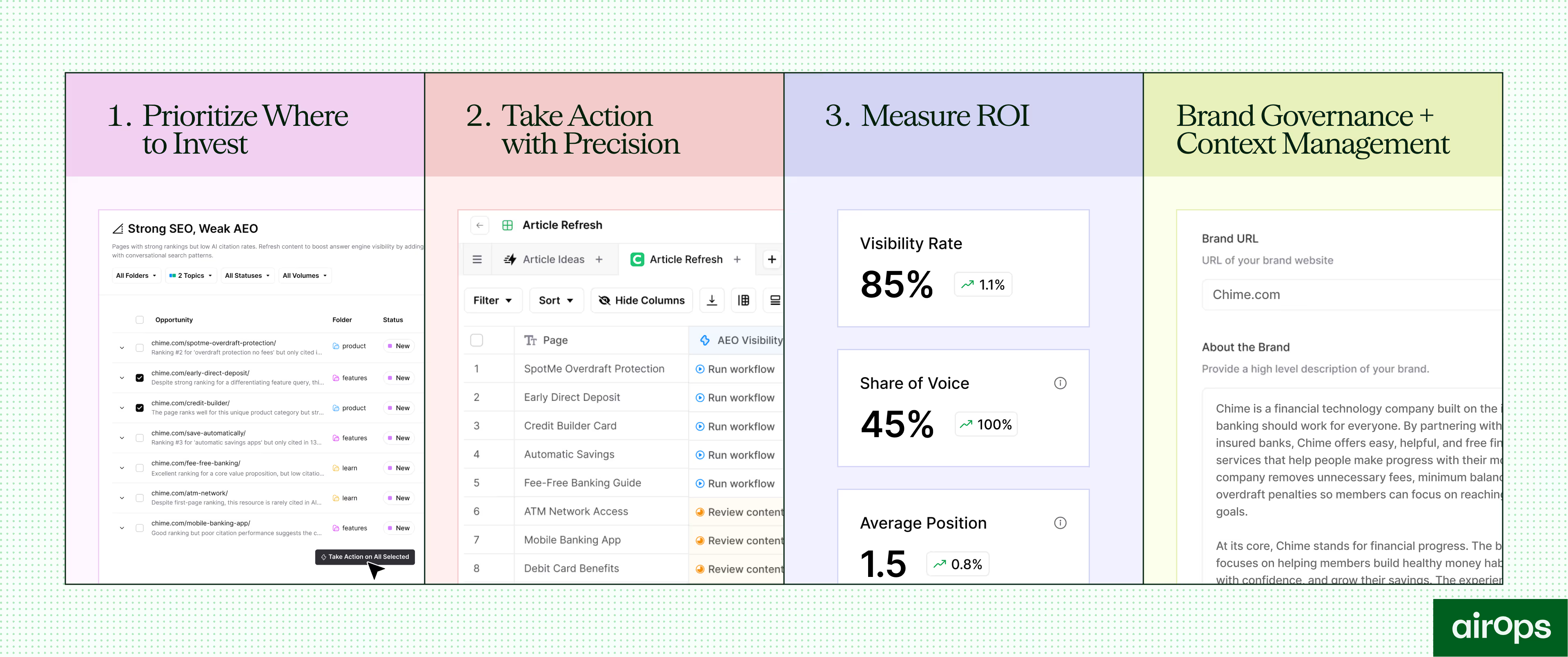
The New System of Action
Crafting content that meets the demands of AI search now depends on a repeatable process that connects strategy, creation, measurement, and trust. This is the new system of action for modern content and marketing teams.
It’s a practical framework any organization can use. The goal is to make visibility measurable and repeatable, using tools and systems that fit your workflow and ignite your team’s creativity.
1. Know exactly what to do next
Use data to know where to focus before you create anything. Visibility grows faster when you prioritize the queries that matter most.
- Dive deep into the topics, prompts, and pages driving visibility and performance.
- Surface opportunities on your site, external sites, and even Reddit threads on a regular cadence
- Prioritize topics based on potential impact and effort, then align your team around the next best moves.
Result: A short list of high-impact topics that tells your team exactly where to invest next.
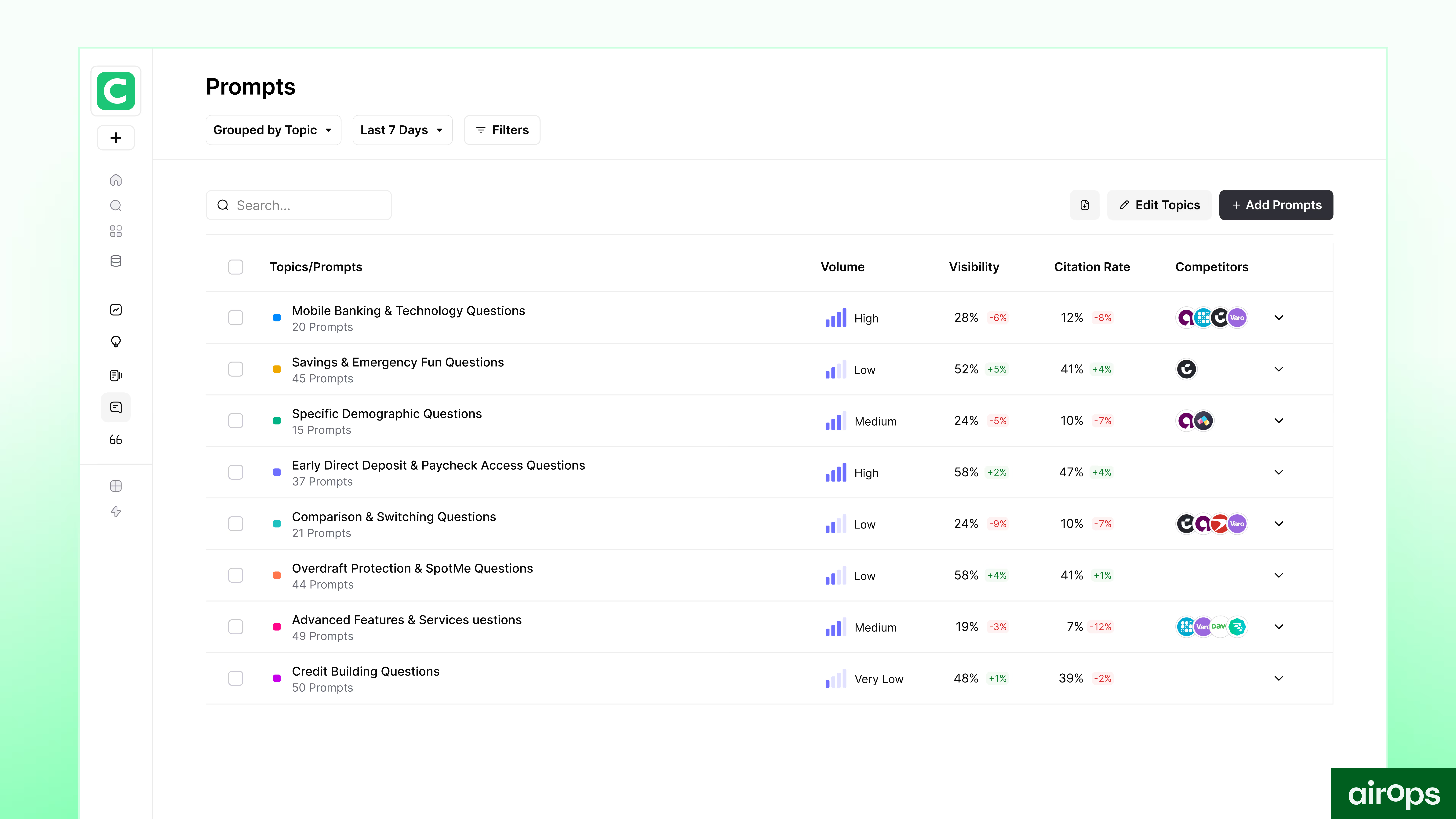
2. Create and refresh with precision
Keep your content system active and relevant. AI search rewards teams that update often and publish with the right structure to be found and cited.
- Combine human expertise with precise AI to bring your brand’s stories to life with workflows for creation and refresh across both owned and earned channels.
- Automate triggers for updates every 60–90 days, or when traffic or citations drop.
- Design templates and review cycles that maintain accuracy, speed, and brand context.
- Centralize where you collaborate with your team to accelerate approvals and stay aligned.
Result: A steady flow of content that stays visible, trusted, and aligned with how humans and AI search.
3. Measure your ROI and impact
The way we measure content performance has changed. Traffic and rankings once defined success, guided by impressions, clicks, and keyword positions. Now, visibility is measured by how often your brand is cited, mentioned, and trusted inside AI answers.
The best teams are shifting to a holistic approach that looks beyond search rankings to understand how the brand shows up across all discovery channels.
In AI search, visibility depends on appearing in trusted, authoritative answers on the topics that matter most.
To do this, don’t chase keyword volume and traffic. Instead, map out your most important topics, the queries that matter most, and where you want your brand to be seen as credible and useful.
What’s the ROI of your content? How has it performed over time? And where does your brand stand today?
What to measure:
- Brand Visibility: How often your company appears in AI-generated answers.
- Citation Rate: How frequently your pages are used as trusted sources.
- Share of Voice: How your visibility compares to competitors across AI search.
- Sentiment: Whether mentions are positive, neutral, or negative.
Result: A clear view of what’s driving growth and where to focus next.
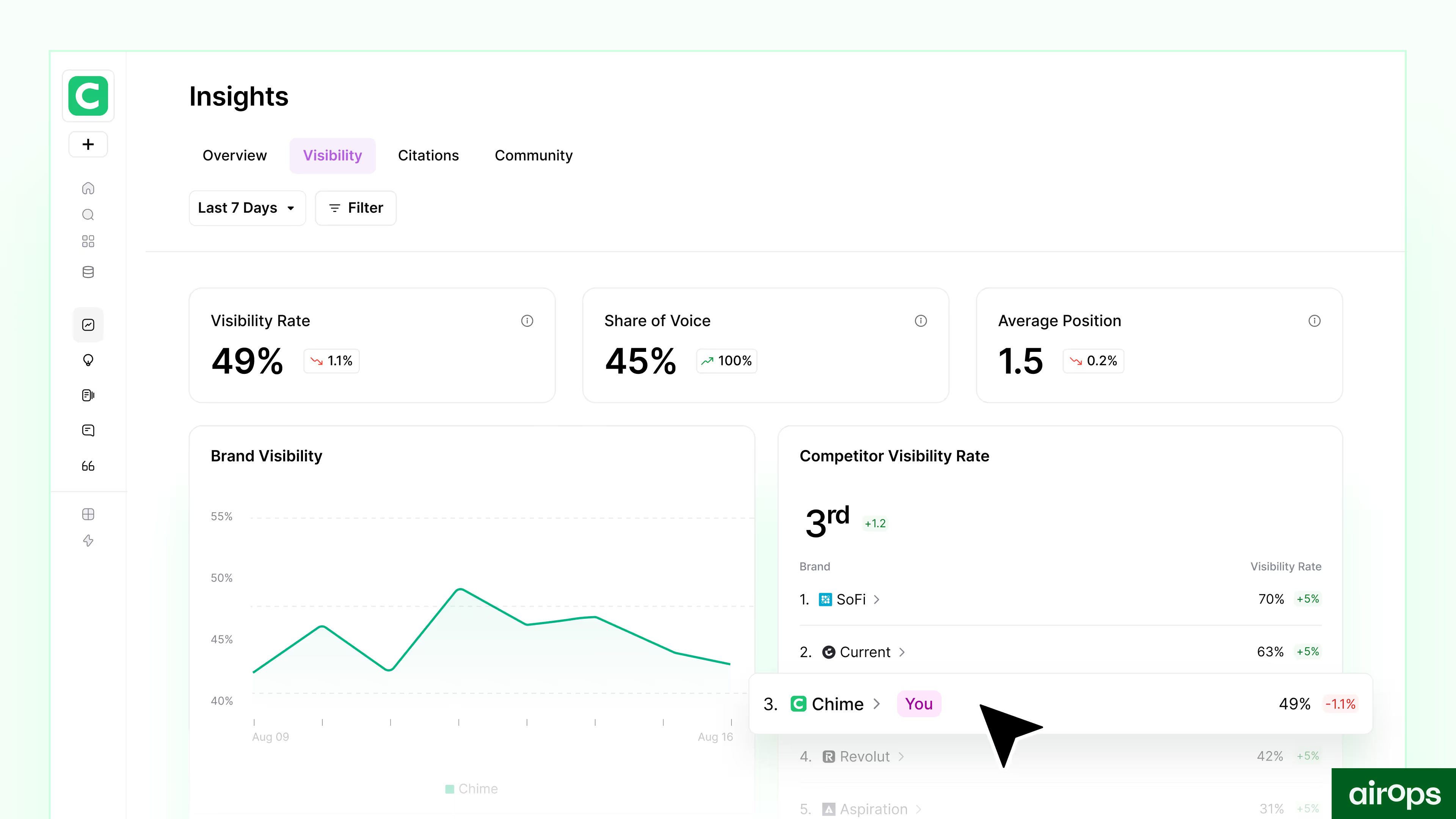
4. Build a system of record for trust
In a world where AI generates endless variations of your message, the real differentiator is consistency. Consistency builds credibility, and credibility fuels authority. A system of record becomes the single source of truth that keeps every workflow, prompt, and piece of content aligned, factual, and unmistakably yours.
It should include:
- Product knowledge: Core features, differentiators, and pricing context.
- Brand voice: Tone, phrasing examples, and common pitfalls to avoid.
- Positioning and messaging: Approved narratives and target personas.
- Data sources: Verified research your team can cite confidently.
- Governance rules: Who owns updates, how changes are approved, and where they’re tracked.
This structure turns scattered information into reusable, trustworthy context that every workflow can draw from.
Each component should stay in sync with your existing systems. Store this information in a knowledge base that grounds every prompt and output. It keeps your context organized, prevents drift, and reduces friction between teams. As your product, positioning, or tone evolves, your outputs evolve too. Your content always reflects who you are now, not who you were six months ago.
Result: A reliable foundation that keeps every message on-brand, factual, and trusted across all channels.

How to Turn the System Into Visibility
The system of action gives teams a repeatable way to plan, create, measure, and maintain trust. To turn that system into real visibility, you need consistent action. The following four plays show how leading teams do it.
1. Create: Originality and structure win visibility
Originality is the moat in AI search. Models reward content that introduces new information, but it also must follow a clear structure they can easily interpret and trust.
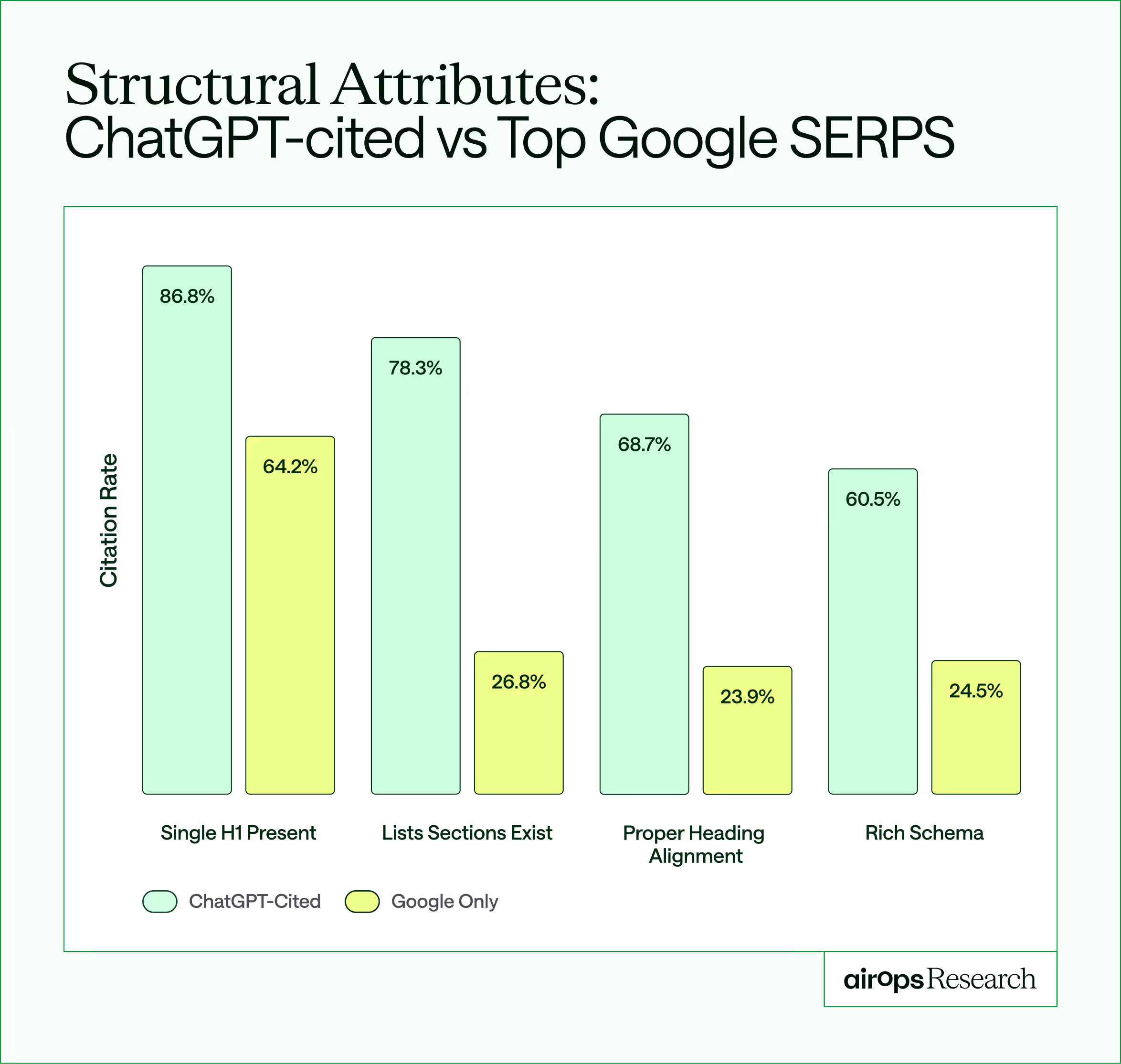
Across more than 12,000 pages analyzed, every structural element tested appeared more frequently in ChatGPT-cited content often by margins of 20 to 40 percentage points compared to Google’s top results.
- Pages with FAQs show a 40% higher likelihood of being cited in AI search.
- Pages with three or more schema types are 13% more likely to earn AI citations.
- A clear heading hierarchy (H1 to H2 to H3) increases citation odds 2.8×.
- Organized lists and tables appear in nearly 80% of ChatGPT citations, compared to 29% in Google’s top results.
At Carta, this approach turned into results fast. By embedding structured authoring and proprietary data into every post, the team achieved a 7× increase in AI citations and a 75 % citation rate on newly published pages without adding headcount.
2. Refresh: Updated content builds trust
Freshness is now one of the strongest signals of trust in AI search. Models consistently favor pages that are recent, accurate, and actively maintained especially for commercial queries tied to purchase decisions.

- 70% of cited pages were updated within the past year on ChatGPT.
- Pages refreshed within 3 months are 3× more likely to be cited.
- Companies in fast-moving industries like SaaS, finance and news sites only have a 3 month window before their content is out of date.
Webflow put this principle into motion by automating refresh workflows across its content library. Update velocity increased fivefold, organic traffic rose 40%, and AI-sourced sign-ups climbed from 2% to 10% in the first 90 days.
3. Third-Party: Offsite signals add validation
Visibility doesn’t stop at your own domain. When AI models surface brands during early-stage commercial discovery, they look for external validation, not what the brand says about itself. In our research analyzing more than 21,000 brands, 85% of brand mentions are sourced from third-party content, not the brand’s own site. This shows that authority now lives across the web, not just on your homepage.
- Brands are 6.5× more likely to be cited through third-party sources than from their own domains, making external validation the dominant driver of visibility in AI search.
- 68% of brand mentions are unique to a single AI model–brands need consistent coverage across external sources to maintain visibility.
- Nearly 90% of all third-party citations come from listicles, comparisons and review sites and 80% of cited brands show up within the first three positions. AI relies on these ranked formats to understand which brands define a category.

As TrustRadius CMO Allyson Havener notes, “The most powerful influence happens where attribution can’t see: visibility in AI answers, peer referrals, and third-party proof. Credibility is the lever.”
4. Social Engagement: Community creates credibility
Community platforms have become the new trust layer of search. AI models now prioritize authentic participation and peer validation over brand promotion.
Our analysis of 5.5M answers found that user-generated citations cluster across four main types of platforms.
- Community Q&A spaces like Reddit and YouTube reward direct expertise and real discussion.
- Social platforms such as LinkedIn and X surface professional commentary and peer validation.
- Community editorial sites like Wikipedia and Medium build authority through collective editing and consensus.
- Review and rating platforms such as G2 and Trustpilot reinforce credibility through user feedback and proof points.
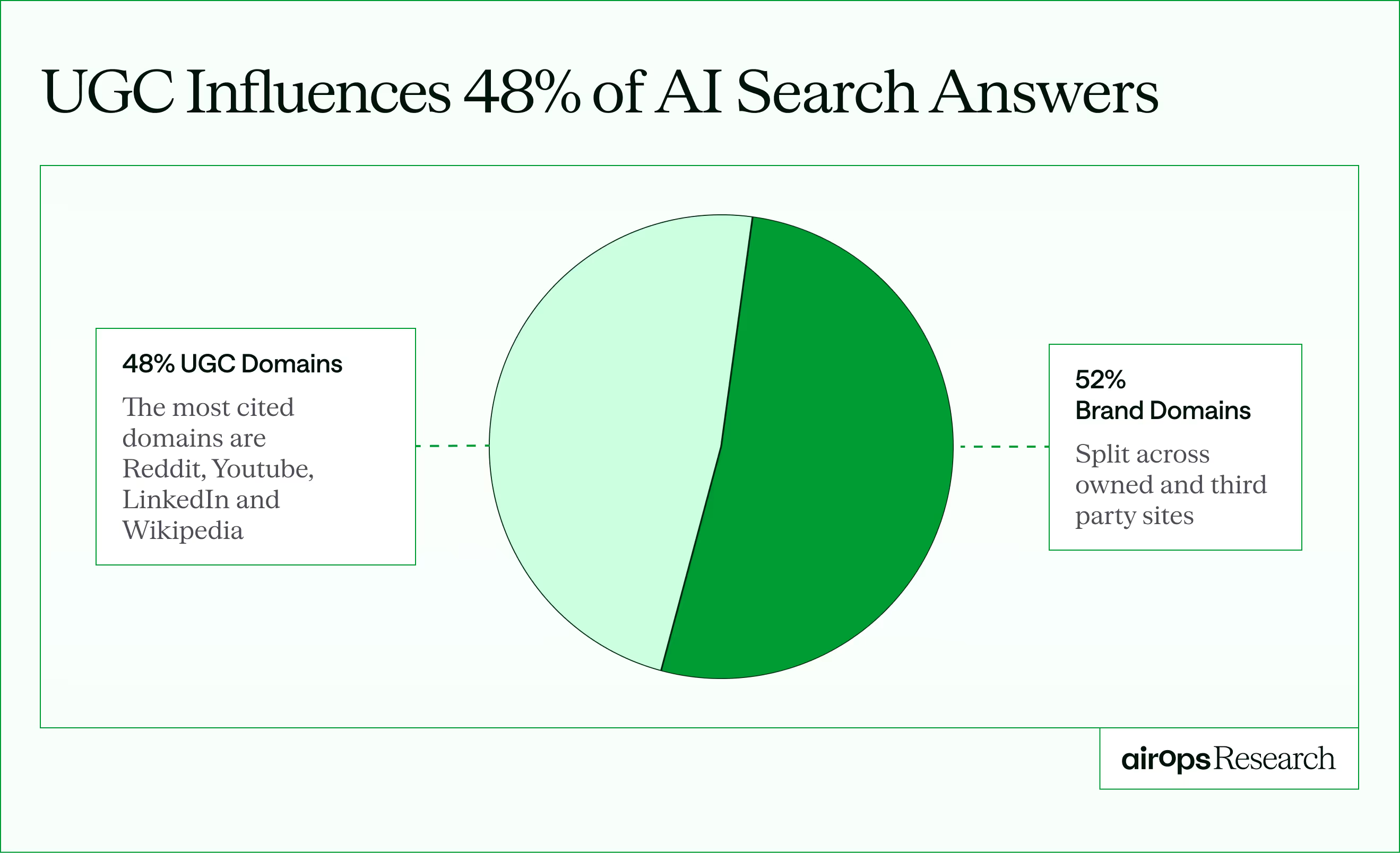
Visibility and awareness happen in real conversations across Reddit, LinkedIn, and YouTube, where the freshest and most authentic insights are shared. These platforms are increasingly cited in AI answers because they reflect what people are actually saying and searching for in real time, not static pages frozen in the past.
- 48% of AI citations come from Reddit, LinkedIn and YouTube.
- Reddit appears as a cited source in about 22% of generated answers.
- 75% of YouTube citations occur in non-branded “how-to” queries where users are exploring, not searching for a specific brand.
LegalZoom focuses on high-impact Reddit discussions that align with its brand. Using AirOps workflows, the team identifies opportunities and drafts responses reviewed for compliance and accuracy reducing their response times from 48 hours to under 30 minutes.
The Compounding Loop
These actions strengthen each other over time. Original ideas create content worth refreshing. Fresh content earns new mentions across trusted sources. Those mentions spark conversations in communities that feed the next wave of ideas. This is how enduring visibility is built: a continuous loop of creation, refresh, validation, and engagement. Teams that keep the loop in motion build authority faster and sustain it longer.
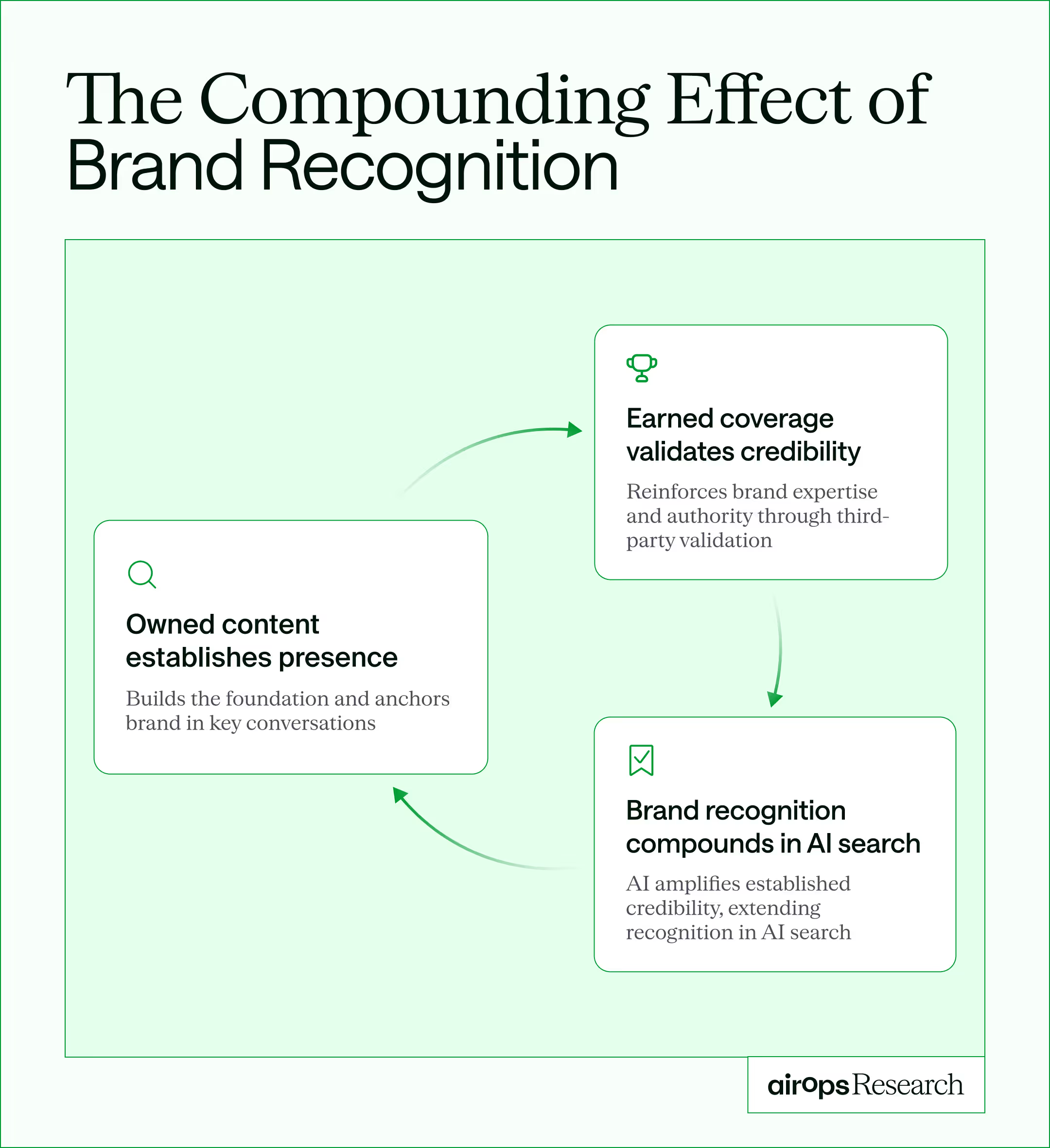
Organize the Team That Powers the System
AI search is exposing every weak spot in content operations. Process, precision, and speed now determine whether your brand gets cited or ignored.
The best teams have moved from content producers to content-led growth systems. These are small, specialized groups that manage context, design workflows, analyze data, and remove roadblocks quickly.
A Context Librarian manages data, taxonomy, and governance. A Content Engineering team builds and maintains the workflows. A Strategy Owner connects those systems to business goals. Together, they form the foundation of a content-led growth system. All of this only works with the right Executive Sponsor who secures budget, alignment, and visibility to help it accelerate.
This model turns content from a deliverable factory into a growth engine. Once in place, it allows teams to grow content and AEO with clarity, precision, and control.

Context Management: Govern brand truth
Content only moves fast when everyone trusts the foundation. This role owns the single source of truth for product definitions, tone, and positioning, built from the inputs of product marketing, legal, and other key teams. By aggregating what matters most across functions, the Context Manager maintains a “context library” that keeps every workflow aligned, accurate, and ready to move with speed.
Result: Every project starts from an approved, reliable context that speeds up collaboration and reduces review cycles.
Content Engineering: Build systems that scale quality
The content engineer designs the workflows that power the entire system. They connect research, briefs, and refreshes into one repeatable process and integrate AI tools without losing human oversight. Their work turns creative ideas into structured, scalable operations.
Result: Higher output, greater precision, and a consistent standard of quality across every channel.
Strategy Lead: Turn data into smart bets
The strategy lead translates visibility and performance data into clear priorities. They identify which topics or formats are compounding results and which need to be retired or refreshed. Their goal is to shorten feedback loops so the team learns faster and focuses on what moves the needle.
Result: Every decision ties back to measurable ROI and the system gets smarter with each cycle.
Executive Sponsor: Clear the path and set the mandate
AI search has become a leadership priority. The executive sponsor provides top-down alignment across marketing, product, and legal. They remove obstacles, secure budgets, and make it clear that speed and experimentation are not optional—they’re expected.
Result: A unified mandate that empowers the team to move fast, make decisions confidently, and scale with support from the top.
Together, these roles form a loop of clarity, execution, and learning. Context librarians define the truth. Content engineers operationalize it. Strategy leads turn insight into action. Executive sponsors keep the path clear.
This structure turns a content team from a production line into a growth engine that’s built for speed, trust, and adaptability.
What to Do Next
This is not the time to slow down. The rules of visibility are changing every quarter, and the advantage now belongs to teams that move with structure. The best teams measure visibility weekly, refresh content quarterly, and keep human and AI systems learning together in one loop.
The shift ahead is bigger than technology alone. Visibility now depends on how well your systems, workflows, and people operate as one connected engine. High-performing teams already think of this as a core operating principle, not a campaign.
If you are ready to see where your brand stands and what it will take to compete, our team can help. AirOps works with marketing and growth leaders to evaluate visibility, identify winning strategies, and design systems of action that match each organization’s goals and structure.
Book a demo if you’re a brand ready to take control of your AI search visibility — and stop flying blind
Get started immediately with this exclusive free trial.


